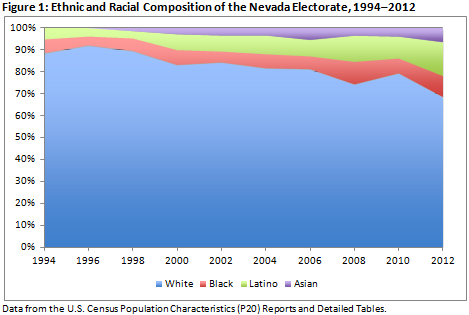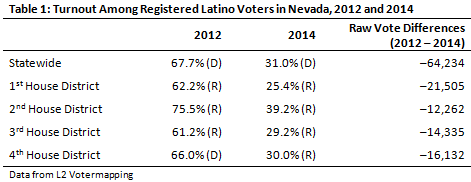In 2004 John Judis and Ruy Teixeria wrote The Emerging Democratic Majority in which they argued that changing demographics were reshaping the country’s political geography in a manner that would help the Democrats win in states where just a decade before the party rarely competed.
The data in Figure 1 summarizing the racial and ethnic distribution of the Nevada electorate in the last ten elections demonstrate these dynamics at work. In 1994, over 90 percent of Nevada voters were white. In 2012, the white share of the electorate shrunk to 67 percent and even though whites continue to vote above their population share, the demographic reshaping of the Nevada electorate has been significant. Most notably, between 1994 and 2012 the Latino share of the electorate tripled from five to 15 percent. Given that Nevada is poised to become majority-minority by decade’s end, the trends depicted in Figure 1 will be accelerating in coming election cycles.

Without equivocation, the infusion of so many minority voters, particularly Latinos, has been the most important factor in shifting Nevada from Republican to Democratic leaning during the last decade. At the same time, the 2014 election indicates how fragile the participation of some of these voters can be as there were nearly a half a million fewer votes cast in Nevada as compared to two years prior.
Democrats disproportionally accounted for the turnout decrease. Indeed, despite a 2014 registration advantage of 62,000 voters, data from L2 Votermapping indicate that Republicans outvoted Democrats at such a rate that Republicans constituted 44 percent of the Nevada electorate as compared to 37 percent for Democrats. With so few Democrats participating, a “safe” Democratic incumbent lost in the 4th House district, the Republicans swept the statewide constitutional offices, and the GOP took control of both chambers of the Nevada Legislature giving the party unified control of state government for the first time since the late 1920s.

Much of the Democrats’ woes stemmed from the party’s inability to mobilize Latino voters; a voting bloc that was pivotal in delivering Nevada for Obama in 2008 and 2012 and in ensuring U.S. Senate Majority Leader Harry Reid’s 2010 reelection. As the data presented in Table 1 indicate, this did not happen in 2014. Specifically, the table uses L2 Votermapping data to estimate statewide Latino turnout and disaggregate these data by House district. For comparison, 2012 turnout rates are included, as is the raw vote differences between 2012 and 2014.[1]
Three key points are apparent from Table 1. First, the decrease in turnout among Latino voters outpaced the state as a whole. Specifically, total 2014 turnout was 46 percent (down from 81 percent in 2012), while Latino turnout was 31 percent. As a consequence, Latinos cast just 10 percent of the votes in 2014 despite constituting 16 percent of registered voters and roughly 20 percent of the age eligible population.
Second, in Nevada’s majority-minority 1st House District, Democrat Dina Titus easily won reelection in a district where Democratic registration outpaces Republican registration by better than two to one. The sharp decline in Latino participation in the first district did, however, impact races elsewhere on the ballot. Most notably, Democrat Ross Miller lost the Attorney General’s race to Adam Laxalt by fewer than 5,000 votes. As one of his first orders of business, Laxalt made Nevada part of the Texas lawsuit opposing President Obama’s November executive action providing relief from deportation for some unauthorized immigrants.
Third, after the 2010 Census, Nevada gained its fourth House seat in no small part because of growth in the state’s Latino population. The majority-minority district, which covers both urban and rural spaces, should, at least on paper, be a Democratic lock. Yet, despite a 33,000 voter registration advantage, Democrat Steven Horsford lost reelection to Crescent Hardy by 3,622 votes. The Republicans also won Nevada’s other two House districts; the safe GOP second and the swing third, which was easily carried by incumbent Republican Joe Heck.
Certainly, there are a number of reasons why so many Latino chose to stay home in November. After three straight elections when top of the ticket Democrats invested heavily in voter registration and GOTV, few of these resources were allocated to Nevada in 2014. The Democrats inability to recruit a credible candidate to run against Republican Governor Brian Sandoval freed up resources for other Republican candidates and allowed the GOP to coordinate its efforts in a manner that had been non-existent in recent election cycles. Add to this the mobilization of conservative voters in opposition to a ballot initiative seeking new business taxes to fund education and the failure of the political system to address immigration, the policy priority for most Latino voters, coupled with President Obama’s decision to delay executive action until late November and the composition of the 2014 Nevada electorate was very different as compared to 2008, 2010, and 2012.
The good news for the Democrats is it appears that Nevada will once again benefit from a hefty infusion of campaign resources and attention in 2016 as Harry Reid’s Senate seat will be up for grabs, and another presidential election looms. Still, the lesson from 2014 is that Latino participation in Nevada and elsewhere is far from a given and the Democrats have their work cut out if they hope to consolidate the Latino vote any time soon.
[1] The 2012 data only account for those who were registered in 2014.
David Damore is a Senior Analyst at Latino Decisions. He is Associate Professor of Political Science at the University of Nevada, Las Vegas, and a Senior Nonresident Fellow in the Brookings Institution’s Governance Studies Program.

